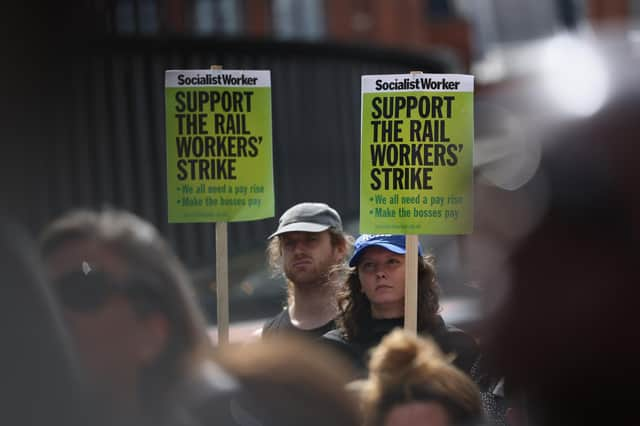Is stagflation on its way back and could UK be hit by a 1980s-style recession? Here's an economist's take – John McLaren


The next bit of the equation is that even with inflation at 24 per cent, average earnings in 1975 rose by almost 30! In fact, from 1971 to 1981, RPI inflation averaged around 13 per cent a year, but earnings rose by about 15, so even in real terms people got wealthier.
As well as the big hikes in the oil price in the 70s, it was fast-rising wages that led to inflation still being 18 per cent in 1980. Of course, the oil price rise was out of the government’s control but wages were not.
Advertisement
Hide AdAdvertisement
Hide AdStrong unions and raised inflation expectations helped secure pay deals well ahead of prices and the cycle continued until another recession in the early 80s squeezed inflation down to a more manageable five per cent.
There are similarities now, with high energy prices pushing up inflation and largely outside the government’s control. The same could be said for the higher food prices stemming from the war in Ukraine and supply chain issues, especially with China, that are a hangover from the Covid pandemic.
What is different, so far, is the lack of domestically generated inflation pressures from higher wages. While settlements, especially in the private sector, have been creeping up, they remain well below inflation.
As long as this is the case, then the chances of stagflation remain remote, which is why the UK Government is keen that the rail workers dispute doesn’t end with a healthy pay rise.
Once the expected peak in inflation has been reached in the autumn – at around 11 per cent after the next energy cap rise – then there should be strong forces pushing it back down.
Energy prices may not fall quickly but they are unlikely to rise further, as it is not in oil producers’ interests to invoke a recession in the West and alternatives to Russian energy sources should start flowing.
The UK Government is adamant that public sector workers won’t get much more than three per cent in pay rises. Private sector settlements are likely to be higher but will vary across sectors and most will still be below the rate of inflation.
So while inflation will remain uncomfortably, for the Bank of England, above the target rate of two per cent, it should be falling, and in some months quite rapidly, as the past year’s big price hikes fall out of the calculation.
Advertisement
Hide AdAdvertisement
Hide AdWhere things may be less comfortable is with regards to growth and unemployment. Growth has already stalled and the chances of a minor recession are in the balance. This will have a knock-on effect on employment, compounded by the impact of higher wages making private sector employers keener to replace more expensive labour with relatively cheaper automation.
As unemployment is at a historically low level at present and any downturn is likely to be mild, there should be no return to the harsh outcomes that resulted from the deep recession of the early 1980s, although the labour market position could yet change.
Further dangers that could lead to a slowdown in growth stem from the increasing fragmentation of the world economy. With Russia now off-limits and China self-isolating, the prospects for trade growth are diminished.
This highlights the extraordinary changes that have taken place in society and the economy as a result of Brexit, the pandemic, and the war in Europe.
None of these issues is likely to be fully resolved for some time to come. That leads to ongoing uncertainty which in turn impacts on behaviour.
Already the reticence of workers to push for inflation-matching pay rises has been surprising, given the high rate of job vacancies. Other behavioural changes that have still to be determined are: what will happen to the extra savings accrued by households during lockdown; and how many of the half million people who left the labour market during the pandemic will decide to re-enter.
Meanwhile, in the upcoming transitional phase, in which inflation is set to peak before starting to fall, the big question is how to best cope with the decline in living standards as price rises continue to outstrip wage rises.
The higher wages go, the longer the inflationary adjustment will take and the more chance that higher inflation will become embedded and permanent. But the lower they are, the more chance that industrial action leads to lasting damage to the economy.
Advertisement
Hide AdAdvertisement
Hide AdThat is the tricky landscape that the Scottish and UK governments and the Bank of England have to traverse in reaching a new equilibrium.
Ideally the hit on household income would be shared out in a progressive manner – that is, with the poorest households suffering the least and the wealthiest the most. The danger of a deeper, wage-inflation-induced recession coming about is that everyone would suffer to a greater degree and those with the least wage bargaining power – often in low-paid jobs – would suffer the most.
Looking beyond these short to medium-term issues, it would not be surprising if pre-pandemic concerns over low inflation returned, as a lack of demand and high savings lead to prices and interest rates moving back towards zero. A different set of worries.
John McLaren is a political economist who has worked in the Treasury, the Scottish Office and for a variety of economic think tanks
Comments
Want to join the conversation? Please or to comment on this article.
